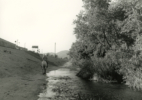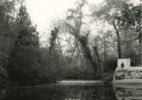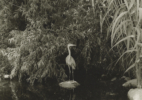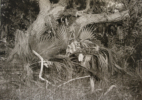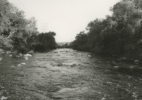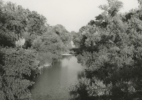Gallery Luisotti is pleased to announce its upcoming exhibition, Mark Ruwedel: Rivers Run Through It. Featuring recent photographs taken along the Los Angeles River and its tributaries, Rivers Run Through It continues Ruwedel’s decades-long interest in capturing places at the confluence of infrastructure and nature. In this new body of work, Ruwedel draws us to the river’s banks and bed, where we find an unexpected palimpsest of social, cultural, and natural history.
For many, the image of the Los Angeles River has been constructed by Hollywood, such as in the car races of Grease or chase scenes of Terminator 2. These cinematic uses of the River have exploited its channelization, the process by which the Army Corps of Engineers encased the river’s natural channel in concrete in 1938. Meant to serve as a means of flood control, the result was devastating for natural ecosystems (with native flora and fauna disappearing from much of the river), saw the loss of sites of indigenous heritage, and has had long term social consequences in the lost opportunity for public greenspace. In response, recent decades have witnessed a revived interest in Southern California’s waterways, with community and governmental support for river revitalization projects.
Mark Ruwedel’s photographs of the river give credence to calls for revitalization, while also making visible the complicated and subtle appeal of a place that exists as a “third ecology.” Coined by Sanford Kwinter, the Los Angeles River as “third ecology” is a place in which the dichotomy of nature/culture has collapsed. As Ruwedel’s camera depicts the river, from the Sepulveda Basin and the Arroyo Seco, to the brackish estuary where the river meets the ocean in Long Beach, the near century old channelization has become overwrought with nature. Ruwedel’s photographs capture the stifling and constricting feral fauna that have taken back much of the river’s course. His camera likewise gives us moments of unexpected natural grandeur as we witness herons, horses, and occasional humans, finding space to roam. Yet we would be mistaken to think Ruwedel wishes us to find beauty along the river, as his camera is impartial to the garbage strewn within bankside foliage. Occasionally this detritus reads as a geological formation, with ubiquitous plastic debris being evidence of our age of petrocapitalism. Still, in other photographs, refuse is a reminder of a natural force that under the right conditions (say, a winter storm) tends toward wild ferocity.
Simultaneous to Mark Ruwedel’s exhibition at Gallery Luisotti, a room featuring his photography will be part of the Tate Modern’s Artist and Society wing. A yearlong re-hanging of the Tate’s permanent collection, Ruwedel’s room gives focus to his documentation of the ways in which historical events have shaped the western landscape. In addition to this great honor, Ruwedel has recently published a number of monographs including Message from the Exterior (London: MACK, 2016) and Dog Houses (New York: August Editions, 2017).




